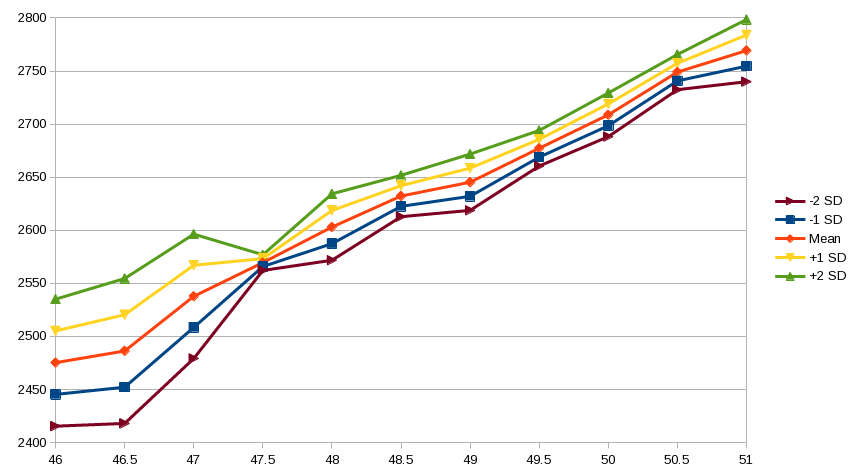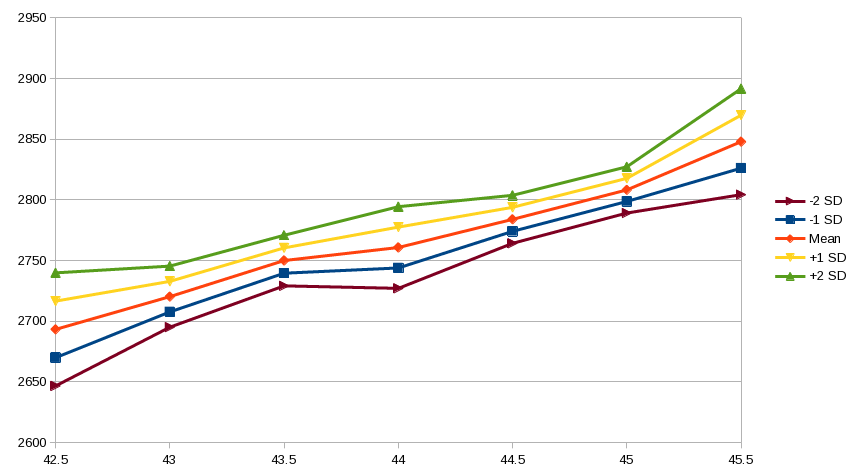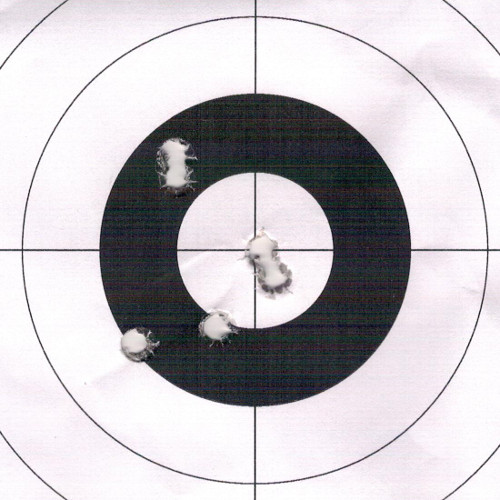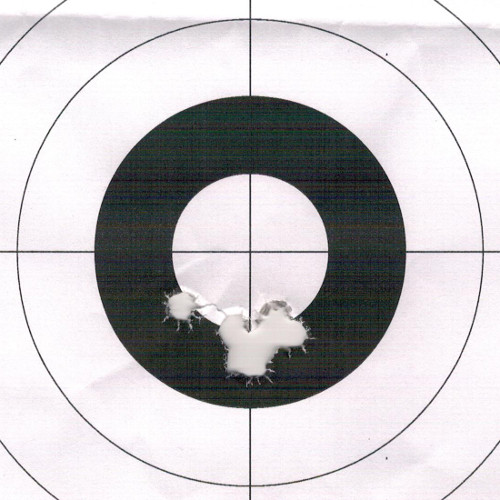2209 is a good choice for your bullet and barrel imo. But i would stop at 44.02grains and choose the 143gn eldx for hunting. I kinda dont see the point of light projectiles whatsoever unless your gun hates heavies (like my 243).
Welcome guest, is this your first visit? Create Account now to join.
Welcome to the NZ Hunting and Shooting Forums.
Search Forums
User Tag List
+ Reply to Thread
Results 16 to 30 of 38
Thread: 6.5x55 SE Sanity Check
-
01-09-2020, 08:42 AM #16
-
-
01-09-2020, 09:02 AM #17
If your shooting a tikka I'm getting out standing results with 143 eldx in front of norma brass fed 210m and 44.8 of 2209 validated at 2720.
I cant shoot any better than that load
Sent from my SM-G950F using TapatalkMy favorite sentences i like to hear are - I suppose so. and Send It!
-
01-09-2020, 09:36 AM #18Member

- Join Date
- Dec 2019
- Location
- Okawa Hawkes Bay
- Posts
- 3,192
Greetings Magnetite,
Looks like your rifle gives a little more velocity than mine with your selection of components. I note that you are using a suppressor which some suggest gives more velocity so perhaps this is part of it. Low standard deviation and extreme spread don't always result in greater accuracy so testing for accuracy is probably the next step. To me 45 grains and 45.5 grains looks like a good place to start. Your velocity is in line with the .260 Rem so your pressures should be a little lower. John Barsness suggested that the 6.5 x 55 needs about 2 grains more powder to equal the .260 Rem velocity at about the same pressure (probably a little less) so I think you are in safe country with either 45.0 or 45.5 grains of AR2209. I wouldn't bother with the lighter loads. Both the 129 grain Hornady Interlock and SST are pretty soft projectiles so don't run the pressures up as much as some of the harder projectiles, especially the Barnes.
Regards Grandpamac.
-
01-09-2020, 09:09 PM #19Member

- Join Date
- May 2020
- Location
- Palmerston North
- Posts
- 277
I did check the group sizes at 100yards but I don't trust them entirely as the wind was up.
Grains 42.5 43 43.5 44 44.5 45 45.5
Max Spread 1.172 0.988 1.290 1.926 1.337 1.496 1.136
Group Height 0.961 0.985 1.283 1.817 1.108 1.462 0.872
Vertical Offset -0.785 -0.105 -0.529 0.332 -0.325 0.610 -0.249
The plan is as follows:
Work up a load with 2213sc. Shoot best load from 2209 and 2213sc and compare. Then move on to seating depth testing.
-
01-09-2020, 10:50 PM #20Member

- Join Date
- May 2020
- Location
- Palmerston North
- Posts
- 277
I botched some of those numbers. Corrected below:
Grains 42.5 43 43.5 44 44.5 45 45.5
Max Spread 1.172 0.994 1.287 1.926 1.326 1.496 1.135
Height 0.961 0.991 0.648 1.817 1.174 1.462 1.039
Vert Offset -0.785 -0.108 -0.200 0.332 0.318 0.446 0.503
Mean Rad 0.496 0.442 0.580 0.696 0.625 0.506 0.47
-
02-09-2020, 06:40 PM #21Member

- Join Date
- Dec 2019
- Location
- Okawa Hawkes Bay
- Posts
- 3,192
Greetings Magnetite,
I tried 49 and 50 grains of AR2213SC behind the 129 grain SST which gave 2,720 and 2,780 fps respectively. You may get a little more. As far as your accuracy figures go you could shoot that string again and get completely different results. For accuracy testing the average of three, three shot groups would give you a better idea.
Regards Grandpamac.
-
12-09-2020, 04:32 PM #22Member

- Join Date
- May 2020
- Location
- Palmerston North
- Posts
- 277
The update no one asked for
Obligatory disclaimer: What you put in your chamber is your business. Some of these loads are over ADI's maximum.
2213SC powder 4 shots each charge:
Grains fps SD ES
46.0 2475 29.9 63
46.5 2486 34.1 73
47.0 2538 29.3 58
47.5 2570 3.7 8 (Several chrono errors in this group)
48.0 2603 15.6 37
48.5 2632 9.7 23 (ADI Maximum)
49.0 2645 13.3 32
49.5 2677 8.4 19
50.0 2709 10.3 23
50.5 2749 8.3 18
51.0 2769 14.7 34

It looks to me that 49.5-50.5gr should be pretty good. The node seems to be a bit wider than the 2209 but you sacrifice 100fps. I didn't see any pressure signs and it's under expected velocities. I not sure what I should call maximum. What's everyone's thoughts on the 2213sc vs 2209 data?
2209 data for easy reading:

Last edited by Magnetite; 12-09-2020 at 04:40 PM.
-
13-09-2020, 01:48 AM #23Member

- Join Date
- May 2012
- Location
- Sydney
- Posts
- 1,817
Iíve always been a group or ladder shooter when looking for new loads. However following Erik Cortina I would now look more closely at ES to zero in on the node.
-
13-09-2020, 03:48 PM #24Member

- Join Date
- May 2020
- Location
- Palmerston North
- Posts
- 277
I like Erik's explanations, and I've cobbled together some form of hybrid method. First off I'm assuming Erik is correct with the charge determines the combustion characteristics (ES/SD) and the seating depth determines harmonics. It seems to me when developing a load your either going for precision or stability. Erik is obviously going for precision, where as the ladder/OCW test are looking for stability. I think with the small sample sizes using SD is preferred. If the samples sizes were larger ES would be preferred.
Using the 2209 data as an example:
Having thought about the data some more it looks like the best way to asses the loads for precision is using the mean Ī2SD to estimate the ES for a given charge (IIRC 2SD should cover 95% of the probabilities). Initially it looks like 44gr may be good with the best ES of 17fps. However when using SD the estimated ES(eES) is 67fps. Choosing 45gr with the worse ES and tighter SD gives a better eES of 38fps.
Now with searching for stability like the ladder/OCW test, it seems the best assessment is to look at two charges next to each other. To do this I take the mean of the higher charge +2SD and subtract the mean of the lower charge -2SD. This gives attempts to simulate an under charge on a cold day and an over charge on a hot day (I don't know how much variance this will give but I think 0.5gr should be fair). The ladder/ocw method as I understand it would select the flat spot in the curve (either looking at velocity or vertical shift doesn't matter). This is 43.5-44gr. Using the above method this gives a shifted ES(sES) of 67fps. However the SD of 44gr isn't that great. Looking at 44.5-45gr even though it isn't a flat spot the sES is 63fps which is better.
One final caveat is because we are dealing with small sample sizes I think that the chosen charges will need to be verified. I don't know who said it but I tend to agree with: 3 shots with show you a bad charge not necessarily a good one.
As for my selected charges here they are in order of preference:
2209 44.8gr ~2790fps
2209 43.8gr ~2755fps
2213sc 48.8gr ~2640fps
2213sc 50.8gr ~2760fps
An interesting point I noticed there may be a shared node at ~2750fps with both powders.
Also if anyone has a better understanding of statistics please chime in (I'm not a statistician by any stretch of the imagination).
Let me know if this makes sense or is closer to the ramblings of a lunatic.
-
13-09-2020, 06:54 PM #25Member

- Join Date
- May 2012
- Location
- Sydney
- Posts
- 1,817
Magnetite,
Years ago I got a distinction for biometrics. However I am pleased I didnít read your post last light half gorged on Shiraz!
While Iím not totally sure I followed your path as you walked it it think you arrived at the right place.
If I followed Erik right after testing for ES and in particular two loads a increment apart worth low Ed he then drill into the space just under the higher load to check precision and then works on seating depth if needed.
Stability I think is determined upfront by powder selection? Burn rate and temp stability. All being equal slow burning and higher case fill% more stable. Your experience may differ?
The other powder to try in the Swede with 140s if available is RL22. It can be rocket fuel in some cases. I really like RL powders despite the supposedly greater temp sensitivity.
-
13-09-2020, 08:41 PM #26Member

- Join Date
- May 2020
- Location
- Palmerston North
- Posts
- 277
The ancient Persians would debate an idea twice: sober and drunk.
I was combining two ideas with stability. Tolerance to temperature, I think that all powders will be affected by temperature just to what extent will vary. And the other idea is tolerance to charge variation. I intend to throw the charges which hopefully should be Ī0.1gr. As for my experience: none. I'm just going off what I've read while I gather my own.
I was planning to try RL19 and RL22 but availability pushed me to ADI. The other nice thing with Alliant is they have data for modern 6.5x55s.
-
13-09-2020, 09:45 PM #27Member

- Join Date
- May 2012
- Location
- Sydney
- Posts
- 1,817
Magnetite,
Sounds like youíre all over it. Between 09, 13sc, 19, 22 and possibly 23/26 and VV 560? ( pm @Thar for his 6.5 Swede loads) you have all the obvious powders for some outstanding loads.
Rl22 at 48.5 behind at 140 SST was a real accurate load in my Rifle.
-
24-10-2020, 02:07 PM #28Member

- Join Date
- May 2020
- Location
- Palmerston North
- Posts
- 277
Accuracy testing
I got round to some accuracy testing and was surprised at the results. Both were 6 shot groups at 100m. I played around with the seating depth for both powders but settled on using the same for each. Each ring on the target is 1 MOA.
44.8gr 2209, ES: 35mm, 1.2MOA

50.8gr 2213SC, ES: 21mm, 0.7MOA

Initially thought that 2209 would be the way to go, but needless to say I will be running 2213SC in the future.
-
23-08-2021, 05:30 PM #29Member

- Join Date
- Apr 2017
- Location
- The 'Naki
- Posts
- 2,631
-
23-08-2021, 06:01 PM #30Member

- Join Date
- Jun 2014
- Location
- CNI
- Posts
- 5,988
I use 44.6 2209 with both 143eldx and Sgk 140 sbt. 0.4- 0.6 moa @ 300m. S&L classic dl.2750fps mv.
Summer grass
Of stalwart warriors splendid dreams
the aftermath.
Matsuo Basho.
Similar Threads
-
Anyone in Aus want to save my sanity?
By Stocky in forum HuntingReplies: 13Last Post: 01-12-2018, 07:59 AM -
Check out the Little dog at end
By Munsey in forum Hunting DogsReplies: 6Last Post: 22-01-2017, 03:12 PM -
check this out
By sakkaranz in forum ShootingReplies: 0Last Post: 13-09-2013, 06:55 PM -
Check out this guy!
By kokako in forum The MagazineReplies: 37Last Post: 07-06-2013, 09:36 PM
Tags for this Thread
Welcome to NZ Hunting and Shooting Forums! We see you're new here, or arn't logged in. Create an account, and Login for full access including our FREE BUY and SELL section Register NOW!!





 33Likes
33Likes LinkBack URL
LinkBack URL About LinkBacks
About LinkBacks



 Reply With Quote
Reply With Quote



Bookmarks